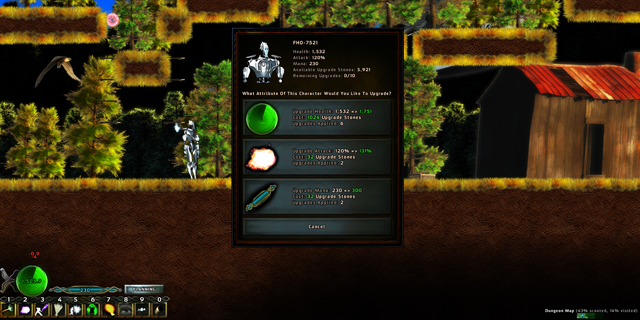
A Valley Without Wind is a unique game and is almost entirely procedurally generated, which means the areas in the game are created randomly. An apocalyptic event has left the world shattered, broken, and untamed, with survivors scattered. Monsters are on the Earth and you are trying to overthrow the Overlord that rules the planet.
The game is very similar to Terraria, in that it is a 2D action game where you look for loot and building materials. While both feature very large and varied worlds and hordes of monsters to avoid, Terraria focuses on manually building and on customization, while A Valley Without Wind focuses on quality Metroid-style combat. This is AVWW’s strongest point — the satisfaction of having so many explosive ways of shooting, the mana management (all attacks require mana but it refills quickly), the smooth movement and jumps, and the dash that you can start in mid-air — all are highly satisfying. Early in the game, you get about a dozen different attacks to play with, and the potential and possibilities are enticing.
The generated world is not endless, but it is very, very large. The entire world is represented on a grid map, a pack of squares that each represent a different area. You can go in one, and then there is a long, long side-scrolling screen. And on that screen might be 12 different houses. And each one of those houses could be a room, or 20 rooms. Most are about a dozen. But then, if it is a mission area, you might run into a tower or other giant edifice wherein you must rescue someone or kill a lot of minibosses. You might also run into a dungeon with many large levels. One square might be about the size of the entirety of a Castlevania or Metroid game, then. You can spend hours and not quite get through that one square. And that is just one square!
You’re not just there to explore, though. You are there to find building materials and upgrade materials. Before you take on the Overlord, there is a lot of spells to upgrade, a lot of buildings that need erecting, a lot of combat materials.
There is a huge list of “things to do” that you can access in the game. That list is generally “kill this” and “collect that.” A lot of it. And the ride is fun at first, but the action plateaus suddenly, and you realize: this is it. This is a grinding and farming engine. I will kill lots of things and find lots of things, without the fun of customizable crafting or appearance-changing of building. Because the “buildings” are just upgrades to a passive status, not built by you, and the upgrade items you find are to cast new spells or to make your old ones stronger and have a different drawing and animation. The adjustable difficulty is a nice addition, but that doesn’t change the essential nature of this game, in that it is a huge and varied farm for one final confrontation.
Fortunately, Arcen updates its games with new content. There is also a co-op mode so you can farm materials and slay endless monsters to your heart’s content. But if you don’t like the alternative art-style or mellow music, or you want something different to happen other than how a building is laid out and where the stuff will be inside it, you will despair for something more exciting. On the other hand, if you just want to jump and platform in zen-like state, lost in thoughtlessness, you could do worse for your surroundings and means of transporation.
Pros: crisp movement and attack mechanics, extremely large procedurally generated world, co-op option
Cons: highly repetitive, even by MMO standards; atypical music and art design not for everyone; little creativity given to player.



















